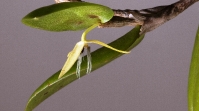Search Results for Tag: Tanzania
Bizarre but valuable: Top 10-list of new species 2011 draws attention to biodiversity
Short time ago the International Institute for Species Exploration at Arizona State University anounced their picks for the top 10 new species described in 2011. It’s the fifth time in a row that attention-grabbing species have been nominated to open the world’s eyes for “the biodiversity crisis and the unsung species explorers and museums who continue a 250-year tradition of discovering and describing the millions of kinds of plants, animals and microbes with whom we share this planet,” as Quentin Wheeler, an entomologist who directs the International Institute for Species Exploration at ASU, said.
When you have a look at the gallery below you will have to admit that this year’s list is quite exquisit. It’s members come from Brazil, Myanmar, the Dutch Caribbean, South Africa, Papua New Guinea, Spain, Borneo, Nepal, China and Tanzania. You will find a sneezing monkey there, a beautiful but venomous jellyfish, an underworld worm and a fungus named for a popular TV cartoon character.
The nominations had to be “species that capture our attention because they are unusual or because they have traits that are bizarre,” said Mary Liz Jameson, an associate professor at Wichita State University who chaired the international selection committee. At the institute’s website you will also find a Google world map that pinpoints the location for each of the top 10 new species.
A comprehensive inventory of Tanzania’s forests
Nearly 20% of green house gas emissions worldwide are caused by deforestation and forest degradation in developing countries. Estimating and reducing these emissions is therefore one of the key goals for the international community as the Rio+20 conference on sustainable development in June draws closer. One country attempting to do just that is Tanzania. The country is currently in the process of drawing up a comprehensive inventory of its forests as you can see in the video above by the Food and Agriculture Organization of the United Nations (FAO). The inventory is meant to help the East African country to better manage its natural resources. Today more than a third of Tanzania is forested, but almost 1% of that forest is being lost annually. The inventory will measure how much carbon is stored within Tanzania’s forests and will help the country to understand the role it can play in mitigating climate change.
French
Spanish
Conservation in Tanzania
The Tanzania Land Conservation Trust, or TLCT, works to preserve and protect wildlife, including Lake Manyara National Park, Tarangire National Park, and all the surrounding land. One of the TLCT's most effective projects has been its work on Manyara Ranch, a 44,000-acre piece of land it took over in 2001.
TLCT, which was created by the African Wildlife Foundation, instituted a series of conservation projects to both protect the region's wildlife and focus on making the Manyara Ranch area better for the communities who live on the land. They've worked to restore the habitat, thanks to both private and local initiatives.
And that hard work has paid off so far. The local farmers have witnessed a revival in their livestock populations, and now they manage cattle in a "conservation-friendly" way. They also moved a school from the wildlife lands to a safer area, to cut down on human-wildlife conflicts. Plus, they created a luxury safari camp to invite a small group of visitors to experience the wildlife–so you can check out Manyara Ranch and the surrounding areas yourself!
Do you have similar conservation projects near you? Or is your region in need of wildlife protection?







Feedback